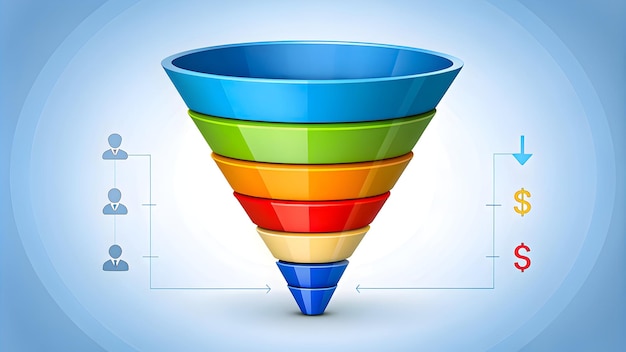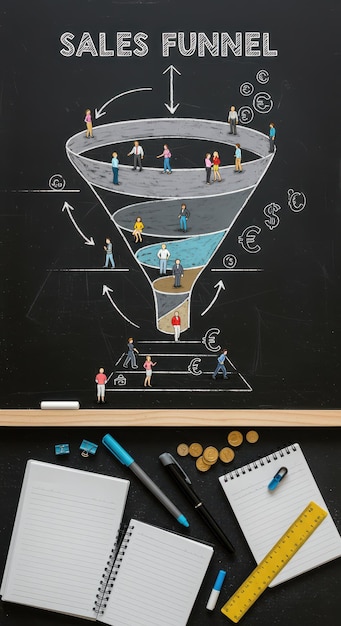An ecommerce sales funnel is a strategic model that maps out the journey a customer takes from the moment they become aware of your brand to the point they make a purchase. This funnel is not just a linear path but a dynamic process that can include loops as customers research, compare, and evaluate their options. By understanding each stage of the funnel, you can tailor your marketing efforts to better meet the needs of your customers at every step of their journey, ultimately enhancing customer satisfaction and increasing sales.
Why is it Important?
The sales funnel is a vital component of any ecommerce strategy because it helps you visualize the customer journey and identify areas for improvement. With a clear view of the funnel, businesses can pinpoint where customers might be dropping off and implement strategies to retain them. By optimizing each stage, you can increase the chances of converting potential customers into loyal buyers, thereby maximizing your return on investment and ensuring sustained business growth in a competitive market.
Building Awareness with Targeted Visibility
At Bedrock Digital, we help ecommerce brands attract and engage customers at the top of the funnel through targeted SEO strategies, engaging content creation, and high-performing paid ad campaigns. Whether it’s ranking for competitive keywords or crafting blog content that educates and builds trust, our team ensures your brand stands out during the Awareness stage. With data-driven insights and compelling creative, we capture attention and drive qualified traffic to your online store, setting the foundation for a high-converting customer journey.
Stages of the Ecommerce Sales Funnel
There are typically four main stages in an ecommerce sales funnel: Awareness, Interest, Decision, and Action. Each stage represents a critical point in the customer’s journey, and understanding these can help you craft strategies to move prospects smoothly through the funnel. Let’s explore each of these stages in detail to comprehend their importance and potential impact on your business.

1. Awareness
At the top of the funnel is the Awareness stage. This is where potential customers first learn about your brand or product. The initial impression you make is crucial, as it sets the tone for all future interactions. The goal here is to capture their attention and make a lasting impression, using compelling messaging and engaging content that resonates with your target audience.
Strategies for the Awareness Stage
- Content Marketing: Create engaging blog posts, videos, and social media content that highlights your brand’s unique value. This content should not only attract visitors to your website but also establish your brand as a thought leader in the industry, fostering trust and credibility.
- SEO Optimization: Ensure that your website is optimized for search engines to increase visibility. Use relevant keywords like “ecommerce funnel” and “funnel marketing” to attract organic traffic, enhancing your site’s search engine ranking and bringing in more qualified leads.
- Paid Advertising: Consider using pay-per-click (PPC) campaigns on platforms like Google Ads or social media channels to reach a broader audience. These ads can be targeted to specific demographics, interests, and behaviors, ensuring your message reaches the right people at the right time.
2. Interest
Once potential customers are aware of your brand, the next step is to pique their interest. This stage is about building relationships and providing valuable information that encourages prospects to learn more about your products. Establishing a connection at this stage is crucial, as it can lead to increased engagement and a higher likelihood of conversion down the line.
Strategies for the Interest Stage
- Email Marketing: Capture email addresses through lead magnets like ebooks or discount codes and send targeted email campaigns that showcase your products and brand story. Personalized emails can help nurture leads by delivering relevant content directly to their inbox, keeping your brand top-of-mind.
- Social Proof: Use reviews, testimonials, and case studies to build trust and credibility with your audience. Positive feedback from existing customers can significantly influence a prospect’s perception of your brand, encouraging them to move further down the funnel.
- Personalized Content: Utilize data from user interactions to deliver personalized recommendations and content that resonates with their interests. By tailoring your messaging to individual preferences, you can create a more engaging and relevant experience that encourages deeper exploration of your offerings.
3. Decision
In the Decision stage, potential customers evaluate your products and compare them with competitors. This is a critical point in the funnel where prospects weigh their options, and it’s essential to provide them with all the information they need to make an informed purchasing decision. Your goal is to stand out by emphasizing your unique selling propositions and addressing any concerns they may have.
Strategies for the Decision Stage
- Product Pages: Ensure your product pages are detailed and informative, featuring high-quality images, descriptions, and specifications. Clear, concise information can help customers understand the benefits and features of your products, making it easier for them to make a decision.
- Competitive Pricing: Offer competitive pricing and highlight any unique selling points that differentiate your products from others. Bundling products or providing exclusive offers can also make your offerings more appealing and encourage purchase decisions.
- Live Chat Support: Provide real-time assistance through live chat to answer any questions or concerns customers may have. Instant support can alleviate doubts, build trust, and potentially speed up the decision-making process.
4. Action
The final stage of the ecommerce sales funnel is Action, where the prospect becomes a customer by making a purchase. This stage is crucial for conversion and requires a smooth and straightforward checkout process. Any friction or complications during checkout can result in abandoned carts, so it’s essential to streamline this process to ensure a positive customer experience.
Strategies for the Action Stage
- Streamlined Checkout: Simplify the checkout process by reducing the number of steps and offering multiple payment options. A seamless checkout experience can reduce cart abandonment rates and increase conversion rates, turning more prospects into customers.
- Limited Time Offers: Create a sense of urgency with limited-time promotions or exclusive deals to encourage immediate purchases. Time-sensitive offers can motivate hesitant buyers to act quickly, boosting sales in the short term.
- Retargeting Ads: Use retargeting ads to remind potential customers of products they viewed but didn’t purchase, nudging them to complete the transaction. These ads can serve as gentle reminders and provide an extra push for customers to finalize their purchase.
Nurturing Interest and Driving Decisions
As customers move into the Interest and Decision stages, Bedrock Digital supports your brand with conversion-focused email marketing, landing pages, and retargeting strategies. We build trust through automation flows, personalized campaigns, and social proof that keeps your brand top-of-mind. Our team also optimizes your product pages and on-site experiences using A/B testing and heatmaps to increase engagement, reduce bounce rates, and guide potential buyers toward confident purchase decisions.

Optimizing Your Ecommerce Funnel
Optimizing your ecommerce funnel involves analyzing each stage to identify bottlenecks and areas for improvement. By continually refining your funnel, you can enhance the customer experience and drive better results. Here are some general tips to enhance your funnel performance:
- Analytics Tools: Use tools like Google Analytics to track user behavior and gather insights into how visitors navigate your site. Understanding these patterns can help you identify pain points and optimize the user journey for better engagement and conversions.
- A/B Testing: Conduct A/B tests on different elements of your website, such as headlines, images, and call-to-action buttons, to determine what resonates best with your audience. Regular testing allows you to make data-driven decisions that can improve your site’s performance and effectiveness.
- Customer Feedback: Regularly seek feedback from customers to understand their pain points and how you can improve their experience. Listening to your customers can provide valuable insights into their needs and preferences, enabling you to tailor your offerings to better meet their expectations.
Converting Action and Maximizing ROI
When it’s time to convert interest into sales, Bedrock Digital ensures that the final steps of the funnel are frictionless and optimized for action. We design fast, mobile-friendly checkout pages, integrate payment gateways seamlessly, and implement urgency-based CTAs that drive immediate results. Beyond the initial sale, we set up follow-up campaigns and upsell strategies to retain customers, boost lifetime value, and maximize your ROI. With our full-funnel ecommerce marketing approach, your business is positioned to grow—strategically and sustainably.
Conclusion
Understanding and optimizing the ecommerce sales funnel is essential for guiding potential customers through the sales process and boosting conversion rates. A well-structured funnel not only enhances the customer journey but also contributes to building long-term relationships with your audience. By focusing on each stage—Awareness, Interest, Decision, and Action—you can create a seamless customer journey that leads to successful transactions and fosters customer loyalty.
Implement the strategies discussed in this article to enhance your ecommerce strategy and watch your conversion rates soar. Remember, the key is to remain adaptable and continuously refine your approach based on customer feedback and market trends. By doing so, you can ensure that your ecommerce business remains competitive and continues to thrive in the ever-evolving digital landscape. For a deeper dive into how successful brands structure their ecommerce funnels, check out Shopify’s Guide to Ecommerce Funnels. It offers practical examples and tips to help you improve each stage of your funnel using proven strategies.
